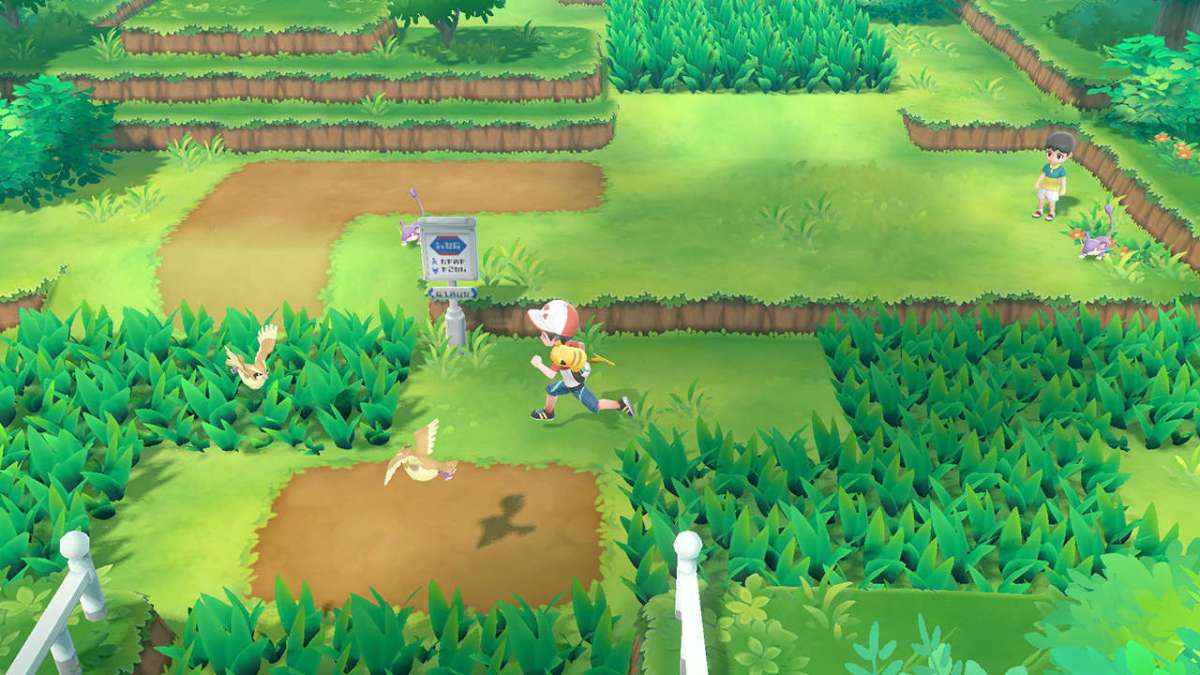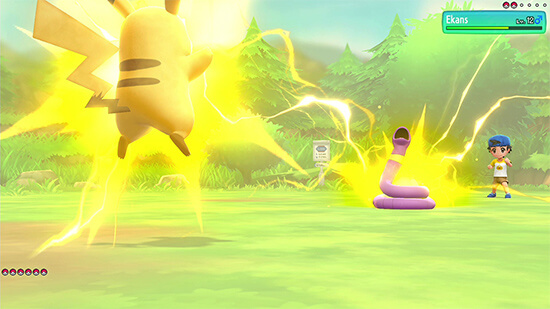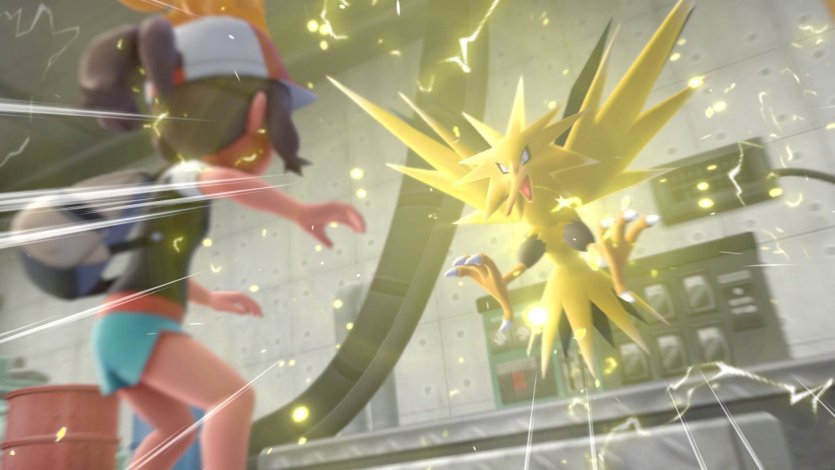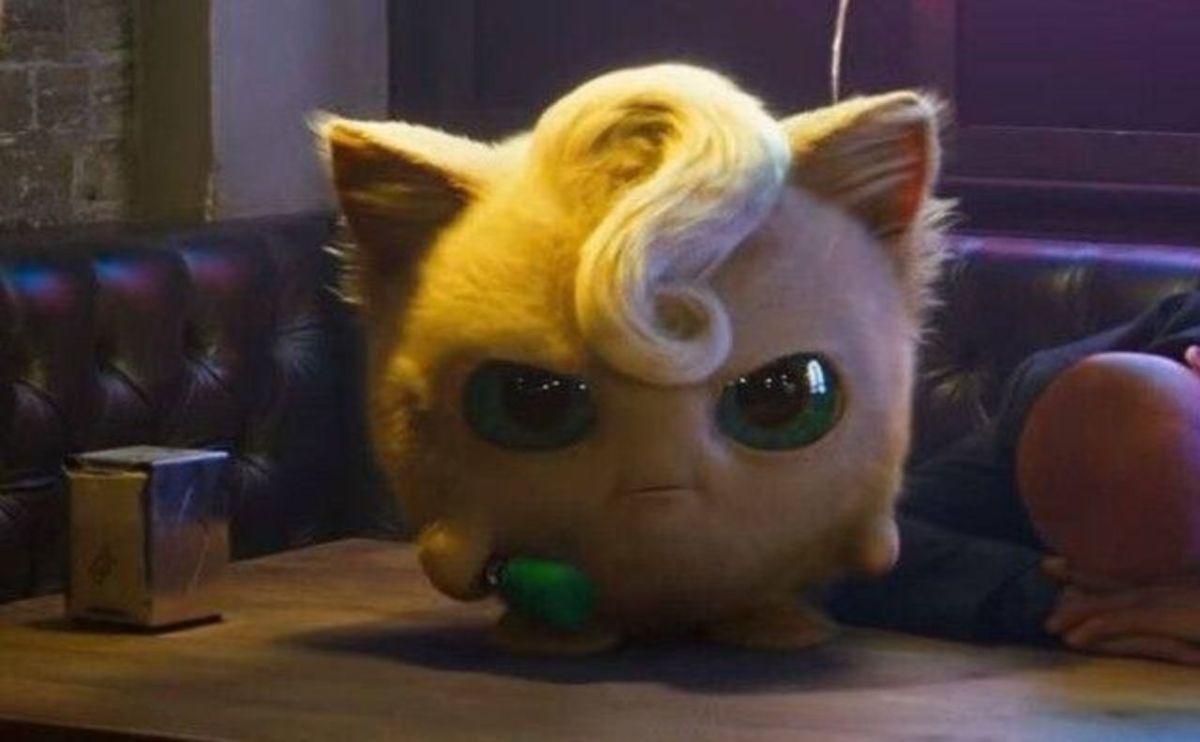Pokémon: Let’s Go Pikachu/Eevee! Bring Overdue Change to Pokémon, If Imperfectly
7 out of 10.
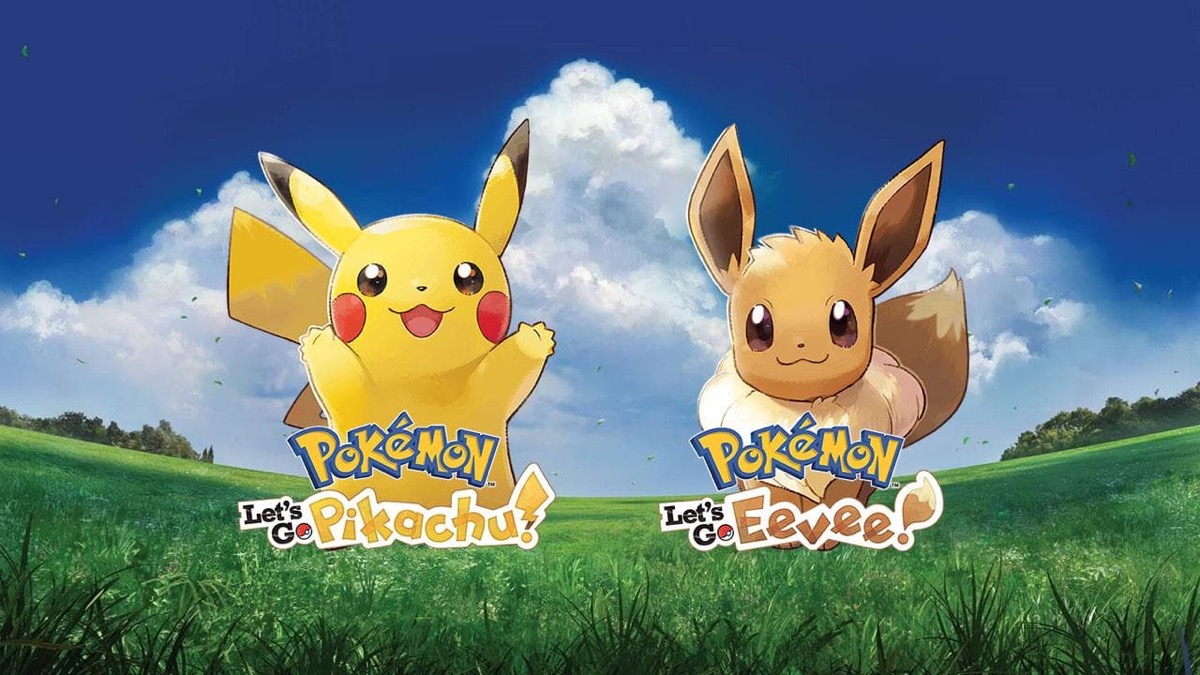
Let’s get this out of the way up front: The Pokémon: Let’s Go games are remakes of the Game Boy’s Pokémon Yellow, itself a remix of the first generation of Pokémon games aimed at capitalizing on the anime’s popularity by incorporating elements of the show back into the games it was based on—hence Pikachu hanging out with the player outside of its Pokéball. As remakes, I can’t help feeling like they deserve to be rated with a bit of leeway (not much, though, considering they’re certainly not priced with leeway).
The intention was never that these two games would be the main Pokémon series’ official, world-shaking landing on a home console—albeit the Nintendo Switch, a console that’s also a portable. Apparently, that game (or games—this is Pokémon, after all) is still to come, and honestly, I hope it takes a cue from these games on actually trying new things, even if it’s not these same new things, when it arrives about a year from now in the second half of 2019.
That’s not to say that every change made for Let’s Go is perfect or even necessarily a step in the right direction, but for a series that has changed as little over time as Pokémon, I’m happy to see it shake things up at all. On top of that, a remake of a game that was already purposefully drawing inspiration from a kid-friendly show is a great place to try some new things in a fun, low-difficulty package.
All that is to say that I don’t understand why these games are attracting the level of hate that they are, up to and including flooding the games with bad reviews. They’re definitely not bad games. I don’t feel comfortable assigning a review score yet, as I’m only about halfway through after starting Let’s Go Pikachu! on Friday (update: I’ve finished the game, assigned a score, and added some closing thoughts at the bottom), but I’ve played enough now to confidently say I’m enjoying myself as much as I have playing any other Pokémon game—and probably more than the last one I played.
Why? Let’s start with the game’s biggest change from the originals: You no longer walk your avatar in circles in tall grass to initiate random battles with wild Pokémon in the hopes of coming across the one you’re looking for. That system is almost entirely gone, replaced by Pokémon that actually pop up out of that grass (and other areas you’d normally find them) and walk around, waiting for you to make contact to get into an encounter with them—or, in some cases, darting straight at you to start one.
You’re still relying on random chance for which Pokémon you encounter, with some being more rare than others, but actually seeing them move around the game world on their own, choosing which ones to interact with, and making your way around the rest is just a lot more interactive and fun on its own. The first Abra I saw, for example, teleported away when I tried to run up to it, as was its habit during battles in the original games. To actually catch one, I had to deliberately sneak up to it.
That alone is something I’m glad to see, but the encounters themselves have also been fundamentally changed, and that seems to be what’s irritating some fans of the series. Instead of battling wild Pokémon to catch them, build up experience points for your team, or add EV points to specific stats (if you’re a more dedicated player), you’re simply presented with a Pokémon-catching mini-game nearly identical to what you’ve almost certainly played in Pokémon Go.
While some gamers have a lot of ire for the trappings of mobile games—due in large part to their free-to-play tactics built more for extracting your real-world money than for fun—after I got used to seeing this in an official Pokémon game, I was relieved not to have to sit through countless battles with weak wild Pokémon, button-mashing my way through menus as fast as possible to end the battle, get some XP, and finally get on with actually playing the game. That’s how things were done in older titles, up to and including 2016’s Pokémon Sun/Moon (the last one I played before this).
The single-player aspect of Pokémon games has never been very difficult, but wild Pokémon battles have always been particularly mindless and, honestly, just not very much fun. They’re a perfunctory relic of older role-playing games that really don’t need to exist anymore, no matter what replaces them. Even characters within the games themselves will remind you that wild Pokémon are naturally weaker than those that have been trained, making them less like actual battles and more like chores to defeat.
Catching wild Pokémon may have been a bit of a deeper experience with that system, but really, in previous games, catching anything less than a legendary Pokémon rarely involved more strategy than lowering the opponent’s HP and throwing several Ultra Balls until one stuck. (You do have to defeat legendary Pokémon in battle before catching them in Let’s Go.) Pokémon Go’s system is a bit simplistic, but the adapted version in Let’s Go has been made at least a bit more interesting for Pokémon that move around as you try to catch them, with those movements not being as easy to just ignore (making the Pokémon-slowing nanab berries actually useful).
But at the end of the day, even if it weren’t any more involved than Go’s system, it’s trading a largely mindless random encounter system for one that’s less random and, in my opinion, less tedious, requiring more actual attention, effort, and skill to bring in the experience points you’re looking to get out of it. (Catching Pokémon gives your entire party experience points in Let’s Go, with bonuses for catching the same Pokémon in succession, as well as for aim and other things.)
I also, honestly, don’t mind that not everything is about fighting. Battling with Pokémon already feels more than a bit like animal abuse, and while I’m perfectly willing to suspend that feeling right along with the rest of my disbelief to play a game, I also don’t mind that I no longer have to go around savagely attacking wild animals, instead feeling more like I’m humanely capturing them for important research (even if the primary benefit of that research still seems to be making them more efficient at fighting).
That makes a lot of sense for a remake of Pokémon Yellow, as the TV show has always felt like it has gone a little further to demonstrate that Pokémon is about friendship than the games. After all, Ash Ketchum got his charmander, for instance, by rescuing it after it was abandoned by an abusive trainer and left to die—not by beating it to within an inch of its life and then throwing a Poké Ball at it.
At the beginning of the game, as in the originals, Professor Oak sends you out to catch tons of Pokémon to help him do research, and I like that this game encourages you to participate in that effort beyond just trying to catch one of each species, or catching multiples just to get one with good battle stats.
Bonus candy items for powering up your own Pokémon’s stats (one way to build up EV stat points, as more experienced players know it) are awarded for catching multiples of a particular species and sending them to the Professor, which mirrors the way Pokémon Go encourages you to catch the same Pokémon multiple times, giving the player more of a reason to be excited to find Pokémon they’ve already caught.
To me, anything that makes tracking down and catching Pokémon more exciting, and more involved in the rest of the gameplay, is a good thing. Yes, players who are very deep into the series already try to track down specific wild Pokémon to battle in order to improve specific stats of their own Pokémon, but this change makes that system more overt and will draw more players into thinking that way and engaging with it.
The bottom line, though, is this: That one major change will largely affect how you feel about the game. I can argue its merits all I want, but if you’d still prefer the days of battling wild Pokémon, or walking around catching Pokémon isn’t fun for you, this just isn’t going to be the game for you. To be fair (and to play armchair game developer for a minute), I personally think an even more interesting addition would be if some Pokémon that are more violent/dangerous than others did force you into battle in a self-defense way, along the lines of Let’s Go’s legendary Pokémon, instead of always defaulting to the catching game.
That could help address the one notable downside of the new system: difficulty. One feeling Pokémon players are likely familiar with is that of being in a remote location, with battle-weary Pokémon, struggling to make it to safety while dreading each wild Pokémon encounter that could possibly be Pokémon’s version of a game over. That element is pretty much absent, since only other Pokémon trainers have the opportunity to try to defeat you, making it easy to backtrack to safety past the ones you’ve already bested in battle.
Let’s Go is undeniably easy for that and several other reasons, including the option to bring in a backup trainer and double-team your opponents, access your entire library of Pokémon at any time outside of battle, and a move your Pikachu can learn early on (on the Pikachu edition, anyway) that’s very strong, always goes first like the familiar quick attack, and always gets a critical hit, greatly increasing damage. That’s not the only powerful special move available to your starting Pokémon of either Eevee or Pikachu throughout the game, either.
It’s a nice way to make up for the fact that Pikachu is actually a pretty weak Pokémon in the games (and that Eevee is kind of boring before its evolutions kick in) without giving in to the anime’s influence and just beefing up its stats, but does feel a bit like overkill. (That could change as I get deeper into the game and the difficulty goes up, but I doubt it.) On the other hand, its animation looks really great, making it super fun to use, so I can’t complain too much.
Outside of those major changes, though, it’s still a pretty familiar Pokémon game, which is where some of my disappointment comes in. That move looks great, and some of the game’s effects look nice in HD—not to mention how cool it is just to see Pokémon like that on my TV in general—but it’s also a pretty small upgrade. Firing up Pokémon Moon on my 3DS, the biggest graphical difference is the resolution.
I’m not expecting the series to go all Detective Pikachu (the movie, not the game) on us and hit us with unsettling uncanny valley Pokémon and photorealistic graphics, but what you get in Let’s Go is definitely the easy way out as far as an HD remake goes. However, that’s at least a choice that I can understand. It’s meant to be a more straightforward remake in that regard, which makes sense even if I might have wanted more, but I’m more confused by the animation shortcuts taken.
With hundreds of Pokémon to account for, it’s understandable that, as the series originally moved into 3D graphics, the developers didn’t go overboard with unique animations for every Pokémon for every single attack. However, now several games in with the bulk of Pokémon animations recycled from older titles, I’d expect a little more effort to be put into selling the battles visually, through additional animation work.
The examples are many, but it’s weird to see my sandshrew use “dig” and simply sink into the floor in a standing position, rather than actually make any kind of digging motion—or motion at all.
It’s equally weird, in a game with so much attention placed on the uniqueness of your starter Pokémon, that sometimes Pikachu’s mouth doesn’t move when it makes sounds, or that it sometimes jumps up and down in its idle pose, with no actual jumping movement. It also pops up in its own mini cutscenes for special moves like chopping down trees, instead of the actual Pokémon on your shoulder doing anything.
Small things like that draw a lot of attention to this being a pretty low-effort remake, and I really hope next year’s entries in the franchise pay a lot closer attention to these details.
There are also some strange quality of life problems, particularly when it comes to using items on Pokémon. When looking at the stats and moves of the Pokémon in your party, there’s no way to give them items for healing, stat boosts, or anything else.
That’s all done on separate screens, meaning, among other things, that you have decide which one of your buddies to upgrade and how before you open the “candy jar” screen to actually feed them the candy that boosts their stats. That leads to a lot of frustrating flipping back and forth, when you’d expect to be able to access all that information on the same screen.
It seems that the games could’ve used some extra polish on some rough edges if they didn’t want to feel like low-investment remakes. Still, I’m glad to play back through a nostalgic game with some very noticeable changes, especially since they make the whole experience flow more smoothly, even if difficulty is sacrificed in the process.
Again, the Pokémon series has never been a terribly difficult one, and reducing that difficulty is, in my mind, a fair trade for a reduction in how much the game feels like an experience-building grind. However, I’m not convinced that these games take their changes far enough to really mark a meaningful update to the franchise on their own.
Reducing that grind clears the way for focusing on other aspects (like paying more than lip service to the idea of trainers and Pokémon becoming close, or hunting down Pokémon to learn about them), but it still feels like a half-measure in truly introducing a modern version of Pokémon, a series that hasn’t changed much in terms of gameplay in 22 years.
Closing thoughts upon completing the game:
I’ve now finished the game, leveled an entire six-Pokémon team to level 100, likewise earned six Pokémon master titles, and taken on and defeated the returning characters. Here are a few closing thoughts on this entry in the franchise:
- The game was too easy. I’m still glad that level-grinding and wild Pokémon encounters were streamlined and less of a chore, but I wish the trainer battles had gotten increased difficulty to make them feel less like minor annoyances intended to impede progress and draw the game out, rather than actual battles. Opposing trainers still mostly had far fewer than six Pokémon each, providing little reason to deploy any real strategy—a problem that has plagued the single-player experience of Pokémon for a long time. Likewise, their AI is bad. Even one of the post-game master trainers should have beaten me, but inexplicably held back from landing the finishing blow.
- The online modes are extremely limited when it comes to playing with strangers.
- I like that the Elite Four/rival battle dialogue changes to note that you’ve become the champion after your first time through.
- There are a few Pokémon outside of legendaries that will actually attack you in the wild, but they’re too few and too predictable, relegated to a familiar scenario in the power plant. I stand by the idea that this would’ve been more interesting sprinkled throughout the game. Also, the game would’ve been far more interesting with even more detail in wild Pokémon behavior on the world map. Tentacool/cruel will creepily pursue you in the water, and more unique behaviors like this would’ve been welcome.
- **SLIGHT SPOILER** I like how the post-game frees you up to travel more easily by riding some Pokémon through the air (which gave me a literal jaw drop when I first accidentally triggered the feature by evolving a Charmeleon into a Charizard on the one path that lets you do so before beating the game). However, the ability has some … visible seams that kind of break the magic of the effect, with certain places you can’t pass over even within the bounds of the game’s map, as well as requiring you to dismount to walk through gates at the borders of some towns.
- The ability to bring Pokémon over from Pokémon Go was a nice touch, and allowed me to add my Pokémon Go starter Charmander—who I’d kept around despite being woefully underpowered beyond any hope of ever being useful in that game without a massive investment of stardust and candy that never made sense to go through with—to my team in Let’s Go, where he’s thriving.
- In the end, I enjoyed the game and didn’t think its Pokémon Go-inspired changes removed anything important from the experience, but I also wish it had gone even further in making changes in other areas.
(featured image: Nintendo)
**Nintendo provided a copy of Pokémon: Let’s Go Pikachu! for this review.**
Want more stories like this? Become a subscriber and support the site!
—The Mary Sue has a strict comment policy that forbids, but is not limited to, personal insults toward anyone, hate speech, and trolling.—
Have a tip we should know? [email protected]
